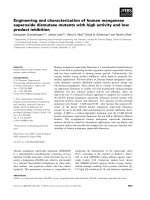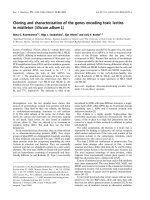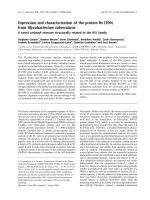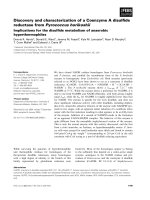Báo cáo khoa học: "Isolation and characterization of a genotype 4 Hepatitis E virus strain from an infant in China" ppt
Bạn đang xem bản rút gọn của tài liệu. Xem và tải ngay bản đầy đủ của tài liệu tại đây (328.61 KB, 4 trang )
BioMed Central
Page 1 of 4
(page number not for citation purposes)
Virology Journal
Open Access
Short report
Isolation and characterization of a genotype 4 Hepatitis E virus
strain from an infant in China
Wen Zhang, Shixing Yang, Quan Shen, Junfeng Liu, Tongling Shan,
Fen Huang, Huibo Ning, Yanjun Kang, Zhibiao Yang, Li Cui, Jianguo Zhu
and Xiuguo Hua*
Address: Zoonosis and Comparative Medicine Group, School of Agriculture and Biology, Shanghai JiaoTong University, 800 Dongchuan Road,
Shanghai, PR China
Email: Wen Zhang - ; Shixing Yang - ; Quan Shen - ;
Junfeng Liu - ; Tongling Shan - ; Fen Huang - ;
Huibo Ning - ; Yanjun Kang - ; Zhibiao Yang - ; Li Cui - ;
Jianguo Zhu - ; Xiuguo Hua* -
* Corresponding author
Abstract
In the present study, a genotype 4 HEV strain was identified in the fecal specimen from a seven
months old infant with no symptom of hepatitis in Shanghai Children's hospital. The full capsid
protein gene (ORF2) sequence of this strain was determined by RT-PCR method. Sequence analysis
based on the full ORF2 sequence indicated that this HEV strain shared the highest sequence identity
(97.6%) with another human HEV strain isolated from a Japanese patient who was infected by
genotype 4 HEV during traveling in Shanghai. Phylogenetic analysis showed that this genotype 4
HEV was phylogenetically far from the genotype 4 HEV strain that was commonly prevalent in
Shanghai swine group, suggesting that this strain may not come from swine group and not involved
in zoonotic transmission in this area.
Findings
Hepatitis E virus (HEV), a member of the genus Hepevi-
rus, is a non-enveloped virus with a positive-stranded
RNA genome approximately 7.2 kb in length [1]. It is a
major cause of acute epidemic and sporadic viral hepatitis
in several developing countries. The infection is believed
to be transmitted by the fecal-oral route, usually through
contaminated drinking water. HEV isolates were divided
into four distinct genotypes according to sequence and
phylogenetic analyses. Genotype 1 was previously
believed to only infect humans, but reportedly detected
from a pig in Cambodia recently [2]. Genotype 2 has only
been identified in humans in Mexico and Africa (Nigeria,
Chad). Genotype 3 is prevalent in swine herds and
humans all over the world. Genotype 4 HEV was first
detected in humans in 1993 [3] and is mainly distributed
in China, Japan, India, Indonesia, and Vietnam. Genotype
4 HEV has a wide host range, being prevalent in humans,
swine, and some other animals. These four types of virus
are thought to comprise a single serotype [4]. Hepatitis E
was first recognized in China after a large epidemic in the
south part of Xinjiang Uighur autonomous region [5].
Since 2000, genotype 4 HEV has become the dominant
cause of hepatitis E disease in China [6].
Published: 16 February 2009
Virology Journal 2009, 6:24 doi:10.1186/1743-422X-6-24
Received: 1 December 2008
Accepted: 16 February 2009
This article is available from: />© 2009 Zhang et al; licensee BioMed Central Ltd.
This is an Open Access article distributed under the terms of the Creative Commons Attribution License ( />),
which permits unrestricted use, distribution, and reproduction in any medium, provided the original work is properly cited.
Virology Journal 2009, 6:24 />Page 2 of 4
(page number not for citation purposes)
Hepatitis E is usually self-limiting and its clinical illness is
usually mild, though fulminant hepatic failure occurs in
some cases. The disease is characterized by a high attack
rate among young adults and particularly severe illness
among pregnant women [5]. To our knowledge, no report
so far indicates that infants have been infected by HEV in
China and this is the first report that HEV infected the
infant that was younger than one year old.
From Feb to Aug, 2008, 236 fecal samples were collected
from 236 infants younger than 2 year old in Shanghai
Children's Hospital, these infants were sent to the hospi-
tal because they had abnormal feces appearance for sev-
eral days. All the samples were converted to 10% (w/v)
suspensions in PBS (0.01 M, pH 7.2–7.4) immediately
following the sampling. Total RNA was extracted from
100 ul suspension of each sample by using TRIZOL rea-
gent (Invitrogen, USA) in accordance with the manufac-
turer's protocol. The viral RNA was finally dissolved in 20
μl RNase-free water. The primers used for HEV sequence
amplification in this study were those previously
described in reference [7]. The PCR products were ana-
lyzed in a 1.5% agarose gel. The expected DNA band spe-
cific for the HEV was excised from the gel, purified with
the AxyPrep DNA Gel Extraction kit (Axygen, USA) and
cloned into pMD T-Vector (TaKaRa, Japan). Both strands
of the inserted DNA amplicons were sequenced in a DNA
analyzer (Applied Biosystems 3730 DNA Analyzer; Invit-
rogen, USA). Standard precautions were used for all pro-
cedures to reduce the possibility of sample contamination
and RNA degradation.
The detection results indicated one specimen from a seven
months old infant was positive for HEV RNA. Sequence
analysis based on the partial ORF2 sequence suggested
that this HEV strain belonged to genotype 4. Then we
determined the full-length nucleotide sequence of ORF2
of this strain using 3 sets of nested primers designed
according the Chinese genotype 4 HEV isolates:
EU366959
, EF570133, and AB197674. The full ORF2
sequence was submitted to GenBank with the accession
no.: FJ373295
, and named Sh-hu-et1. The ORF2 of this
isolate contain 2025 nt, and encodes a potential 674 aa
polypeptide.
In order to investigate the evolutionary relationship of the
HEV isolate in this study with other Chinese genotype 4
isolates, sequences were aligned using ClustaX v1.8 or
MegAlign program in the DNASTAR software package.
Phylogenetic tree was constructed using the Mega 4 soft-
ware />. Ten Chinese geno-
type 4 HEV strains with complete genome available in
GenBank (including both swine and human original iso-
lates) were used as references in the analysis; their Gen-
Bank accession numbers and source of origin are showed
in Fig. 1. Sequence analysis (Fig. 2) based on full OFR2
sequences indicated the isolate in the present study shared
87.2–97.6% identities with the other Chinese genotype 4
HEV isolates referenced here, and the highest sequence
identity (97.6%) with another Shanghai HEV strain
(AB197674
) isolated from a Japanese patient who was
reportedly infected during traveling in Shanghai of China
[8]. Phylogenetic analysis indicated that the isolate deter-
mined in this study closely clustered with other 3 Chinese
genotype 4 HEV strains from human (Fig. 1), forming a
subgroup. Interestingly, though the 4 HEV strains in this
subgroup come from three geologically far regions:
Shanghai (eastern China), Xi'an (western China) and
Guangxing (southern China), they shared more than 90%
nucleotide homologue with each other, suggesting they
may come from a common ancestor isolate. Recent
reports suggested that genotype 4 HEV isolates that preva-
lent in Shanghai humans showed phylogenetically close
relationship with those swine genotype 4 HEV isolates
commonly prevalent in Shanghai swine populations
[9,10], suggesting that zoonotic transmission of genotype
4 HEV between human and swine populations was
involved in this area. However, the isolate, Sh-hu-et1, in
the current study and the other two previous Shanghai
human isolates (AB197674
, and AB369688) were phylo-
genetically far from the swine genotype 4 HEV isolate
(EF570133
) (Fig. 1) which was reported to be commonly
prevalent in Shanghai swine groups [11], suggesting that
some HEV strains that prevalent in Shanghai humans may
not come from swine and didn't participate in zoonotic
transmission. Further investigating research in swine
groups should be aimed to determined the whether this
genotype 4 HEV strain is prevalent in Shanghai swine or
not.
HEV paly an important role in acute sporadic and epi-
demic viral hepatitis in Asia and Africa. Although HEV
infection is frequent in young adults aged 15–20 years, it
is uncommon in children and usually asymptomatic and
anicteric [12]. Many reports indicated that anti-HEV IgG
could be detected in serum of children [13], but few cases
showed HEV RNA positive. In the present study, we
detected HEV RNA in the fecal sample from a seven
months old infant and this infant showed no clinical
symptom of hepatitis, which suggested that infants may
be sub-clinically infected by HEV.
Conclusion
In conclusion, our study showed that a genotype 4 HEV
strain infected a seven months old infant with no symp-
tom of hepatitis in Shanghai Children's hospital.
Sequence analysis based on the full ORF2 sequence indi-
cated that this HEV strain shared the highest sequence
identity with another human HEV strain isolated from a
Japanese patient who was infected by genotype 4 HEV
Virology Journal 2009, 6:24 />Page 3 of 4
(page number not for citation purposes)
Phylogenetic analysis based on the complete ORF2 sequence of the isolate in this study and other 10 genotype 4 HEV isolates in China, using the neighbor-joining method and evaluated using the interior branch test method with Mega 4 softwareFigure 1
Phylogenetic analysis based on the complete ORF2 sequence of the isolate in this study and other 10 genotype
4 HEV isolates in China, using the neighbor-joining method and evaluated using the interior branch test
method with Mega 4 software. Percent bootstrap support is indicated at each node. The scale bar represents nucleotide
substitutions per base. GenBank accession no. and origin are indicated. A genotype 1 HEV strain was included as outgroup.
Sequence analysis based on the complete ORF2 sequence of the isolate in this study and other 10 genotype 4 HEV isolates in China, using DNAstar software packageFigure 2
Sequence analysis based on the complete ORF2 sequence of the isolate in this study and other 10 genotype 4
HEV isolates in China, using DNAstar software package.
Publish with BioMed Central and every
scientist can read your work free of charge
"BioMed Central will be the most significant development for
disseminating the results of biomedical research in our lifetime."
Sir Paul Nurse, Cancer Research UK
Your research papers will be:
available free of charge to the entire biomedical community
peer reviewed and published immediately upon acceptance
cited in PubMed and archived on PubMed Central
yours — you keep the copyright
Submit your manuscript here:
/>BioMedcentral
Virology Journal 2009, 6:24 />Page 4 of 4
(page number not for citation purposes)
during traveling in Shanghai. Phylogenetic analysis
showed that this genotype 4 HEV was phylogenetically far
from the genotype 4 HEV strain that was commonly prev-
alent in Shanghai swine group, suggesting that this strain
may not come from swine group and not involved in
zoonotic transmission in this area.
Competing interests
The authors declare that they have no competing interests.
Authors' contributions
All authors participated in the planning of the project.
XGH was the leader of the project. WZ, SXY, QS, and TLS
collected all samples and performed the RT-PCR experi-
ments for HEV RNA. WZ and SXY did the phylogenetic
analysis. All authors read and approved the final manu-
script.
Acknowledgements
We thank Dr. Meijue Chen (Shanghai Children's Hospital) for her help with
the sample collection.
References
1. Reyes GR, Purdy MA, Kim JP, Luk KC, Young LM, Fry KE, Bradley
DW: Isolation of a cDNA from the virus responsible for
enterically transmitted non-A, non-B hepatitis. Science 1990,
247:1335-1339.
2. Caron M, Enouf V, Than SC, Dellamonica L, Buisson Y, Nicand E:
Identification of genotype 1 hepatitis E virus in samples from
swine in Cambodia. J Clin Microbiol 2006, 44:3440-3442.
3. Huang R, Nakazono N, Ishii K, Kawamata O, Kawaguchi R, Tsukada
Y: Existing variations on the gene structure of hepatitis E
virus strains from some regions of China. J Med Virol 1995,
47:303-308.
4. Panda SK, Thakral D, Rehman S: Hepatitis E virus. Rev Med Virol
2007, 17:151-180.
5. Zhuang H, Cao XY, Liu CB, Wang GM: Enterically transmitted
non-A, non-B hepatitis in China. In Viral hepatitis C, D, and E
Edited by: Shikata T, Purcell RH, Uchida T. Amsterdam-New York-
Oxford: Excerpta. Medica; 1991:277-285.
6. Wang Y: Epidemiology, molecular biology and zoonosis of
genotype IV hepatitis E in China. Chin J Epidemiol 2003,
24:618-622.
7. Cooper K, Huang FF, Batista L, Rayo CD, Bezanilla JC, Toth TE, Meng
XJ: Identification of genotype 3 hepatitis E virus (HEV) in
serum and faecal samples from pigs in Thailand and Mexico,
where genotype 1 and 2 HEV strains are prevalent in the
respective human populations. J Clin Microbiol 2005,
43:1684-1688.
8. Koike M, Takahashi K, Mishiro S, Matsui A, Inao M, Nagoshi S, Ohno
A, Mochida S, Fujiwara K: Full-length sequences of two hepatitis
e virus isolates representing an eastern china-indigenous
subgroup of genotype 4. Intervirology 2007, 50(3):181-189.
9. Zheng Y, Ge S, Zhang J, Guo Q, Ng M, Wang F, Xia N, Jiang Q: Swine
as a principal reservoir of hepatitis E virus that infects
humans in eastern China. J Infect Dis 2006, 193:1643-1649.
10. Zhang W, Shen Q, Mou J, Gong G, Yang Z, Cui L, Zhu J, Ju G, Hua X:
Hepatitis E virus infection among domestic animals in east-
ern China. Zoonoses Public Health 2008, 55(6):291-298.
11. Shen Q, Zhang W, Cao X, Mou J, Cui L, Hua X: Cloning of full
genome sequence of hepatitis E virus of Shanghai swine iso-
late using RACE method.
Virol J 2007, 4:98.
12. Krawczynski K: Hepatitis E. Hepatology 1993, 17:93241.
13. Li RC, Ge SX, Li YP, Zheng YJ, Nong Y, Guo QS, Zhang J, Ng MH, Xia
NS: Seroprevalence of hepatitis E virus infection, rural south-
ern People's Republic of China. Emerg Infect Dis 2006,
12(11):1682-1688.









